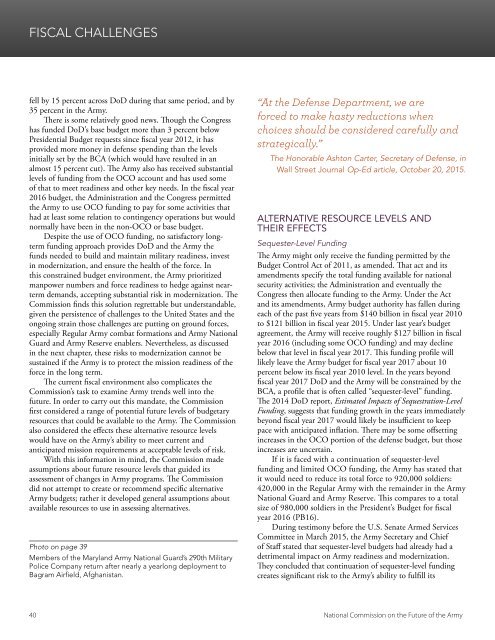THE FUTURE OF THE ARMY
NCFA_Full%20Final%20Report_0
NCFA_Full%20Final%20Report_0
Create successful ePaper yourself
Turn your PDF publications into a flip-book with our unique Google optimized e-Paper software.
FISCAL CHALLENGES<br />
fell by 15 percent across DoD during that same period, and by<br />
35 percent in the Army.<br />
There is some relatively good news. Though the Congress<br />
has funded DoD’s base budget more than 3 percent below<br />
Presidential Budget requests since fiscal year 2012, it has<br />
provided more money in defense spending than the levels<br />
initially set by the BCA (which would have resulted in an<br />
almost 15 percent cut). The Army also has received substantial<br />
levels of funding from the OCO account and has used some<br />
of that to meet readiness and other key needs. In the fiscal year<br />
2016 budget, the Administration and the Congress permitted<br />
the Army to use OCO funding to pay for some activities that<br />
had at least some relation to contingency operations but would<br />
normally have been in the non-OCO or base budget.<br />
Despite the use of OCO funding, no satisfactory longterm<br />
funding approach provides DoD and the Army the<br />
funds needed to build and maintain military readiness, invest<br />
in modernization, and ensure the health of the force. In<br />
this constrained budget environment, the Army prioritized<br />
manpower numbers and force readiness to hedge against nearterm<br />
demands, accepting substantial risk in modernization. The<br />
Commission finds this solution regrettable but understandable,<br />
given the persistence of challenges to the United States and the<br />
ongoing strain those challenges are putting on ground forces,<br />
especially Regular Army combat formations and Army National<br />
Guard and Army Reserve enablers. Nevertheless, as discussed<br />
in the next chapter, these risks to modernization cannot be<br />
sustained if the Army is to protect the mission readiness of the<br />
force in the long term.<br />
The current fiscal environment also complicates the<br />
Commission’s task to examine Army trends well into the<br />
future. In order to carry out this mandate, the Commission<br />
first considered a range of potential future levels of budgetary<br />
resources that could be available to the Army. The Commission<br />
also considered the effects these alternative resource levels<br />
would have on the Army’s ability to meet current and<br />
anticipated mission requirements at acceptable levels of risk.<br />
With this information in mind, the Commission made<br />
assumptions about future resource levels that guided its<br />
assessment of changes in Army programs. The Commission<br />
did not attempt to create or recommend specific alternative<br />
Army budgets; rather it developed general assumptions about<br />
available resources to use in assessing alternatives.<br />
Photo on page 39<br />
Members of the Maryland Army National Guard’s 290th Military<br />
Police Company return after nearly a yearlong deployment to<br />
Bagram Airfield, Afghanistan.<br />
“At the Defense Department, we are<br />
forced to make hasty reductions when<br />
choices should be considered carefully and<br />
strategically.”<br />
The Honorable Ashton Carter, Secretary of Defense, in<br />
Wall Street Journal Op-Ed article, October 20, 2015.<br />
ALTERNATIVE RESOURCE LEVELS AND<br />
<strong>THE</strong>IR EFFECTS<br />
Sequester-Level Funding<br />
The Army might only receive the funding permitted by the<br />
Budget Control Act of 2011, as amended. That act and its<br />
amendments specify the total funding available for national<br />
security activities; the Administration and eventually the<br />
Congress then allocate funding to the Army. Under the Act<br />
and its amendments, Army budget authority has fallen during<br />
each of the past five years from $140 billion in fiscal year 2010<br />
to $121 billion in fiscal year 2015. Under last year’s budget<br />
agreement, the Army will receive roughly $127 billion in fiscal<br />
year 2016 (including some OCO funding) and may decline<br />
below that level in fiscal year 2017. This funding profile will<br />
likely leave the Army budget for fiscal year 2017 about 10<br />
percent below its fiscal year 2010 level. In the years beyond<br />
fiscal year 2017 DoD and the Army will be constrained by the<br />
BCA, a profile that is often called “sequester-level” funding.<br />
The 2014 DoD report, Estimated Impacts of Sequestration-Level<br />
Funding, suggests that funding growth in the years immediately<br />
beyond fiscal year 2017 would likely be insufficient to keep<br />
pace with anticipated inflation. There may be some offsetting<br />
increases in the OCO portion of the defense budget, but those<br />
increases are uncertain.<br />
If it is faced with a continuation of sequester-level<br />
funding and limited OCO funding, the Army has stated that<br />
it would need to reduce its total force to 920,000 soldiers:<br />
420,000 in the Regular Army with the remainder in the Army<br />
National Guard and Army Reserve. This compares to a total<br />
size of 980,000 soldiers in the President’s Budget for fiscal<br />
year 2016 (PB16).<br />
During testimony before the U.S. Senate Armed Services<br />
Committee in March 2015, the Army Secretary and Chief<br />
of Staff stated that sequester-level budgets had already had a<br />
detrimental impact on Army readiness and modernization.<br />
They concluded that continuation of sequester-level funding<br />
creates significant risk to the Army’s ability to fulfill its<br />
40 National Commission on the Future of the Army


